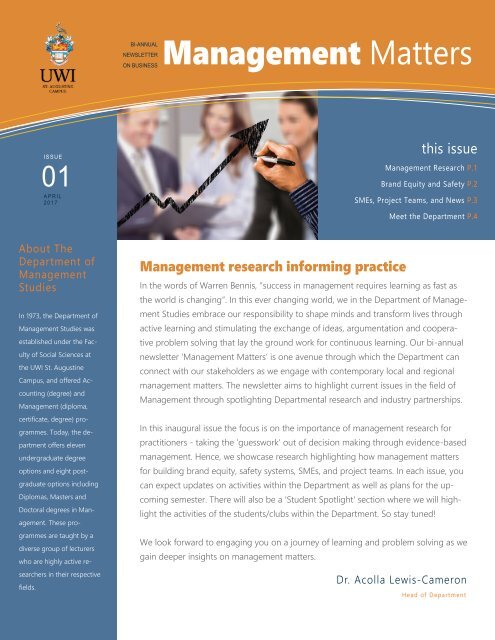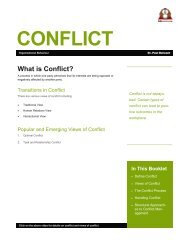DMS Newsletter Draft 2
Create successful ePaper yourself
Turn your PDF publications into a flip-book with our unique Google optimized e-Paper software.
In 1973, the Department of<br />
Management Studies was<br />
established under the Faculty<br />
of Social Sciences at<br />
the UWI St. Augustine<br />
Campus, and offered Accounting<br />
(degree) and<br />
Management (diploma,<br />
certificate, degree) programmes.<br />
Today, the department<br />
offers eleven<br />
undergraduate degree<br />
options and eight postgraduate<br />
options including<br />
Diplomas, Masters and<br />
Doctoral degrees in Management.<br />
These programmes<br />
are taught by a<br />
diverse group of lecturers<br />
who are highly active researchers<br />
in their respective<br />
fields.<br />
In the words of Warren Bennis, “success in management requires learning as fast as<br />
the world is changing”. In this ever changing world, we in the Department of Management<br />
Studies embrace our responsibility to shape minds and transform lives through<br />
active learning and stimulating the exchange of ideas, argumentation and cooperative<br />
problem solving that lay the ground work for continuous learning. Our bi-annual<br />
newsletter ‘Management Matters’ is one avenue through which the Department can<br />
connect with our stakeholders as we engage with contemporary local and regional<br />
management matters. The newsletter aims to highlight current issues in the field of<br />
Management through spotlighting Departmental research and industry partnerships.<br />
In this inaugural issue the focus is on the importance of management research for<br />
practitioners - taking the 'guesswork' out of decision making through evidence-based<br />
management. Hence, we showcase research highlighting how management matters<br />
for building brand equity, safety systems, SMEs, and project teams. In each issue, you<br />
can expect updates on activities within the Department as well as plans for the upcoming<br />
semester. There will also be a 'Student Spotlight' section where we will highlight<br />
the activities of the students/clubs within the Department. So stay tuned!<br />
We look forward to engaging you on a journey of learning and problem solving as we<br />
gain deeper insights on management matters.
Strong brands increase<br />
customer trust and reduce<br />
skepticism in purchase<br />
decisions. Strong brands<br />
also give service providers<br />
a tangible forum to differentiate<br />
an otherwise intangible<br />
product category.<br />
Building strong brands in<br />
services can be challenging.<br />
Dr. Meena Rambocas<br />
and Professor Surendra<br />
Arjoon conducted a study<br />
to examine the factors that<br />
contribute to building<br />
strong brands in financial<br />
services.<br />
In their study, Dr. Rambocas<br />
and Professor Arjoon map the<br />
contribution of three unique<br />
services related attributes:<br />
service experience, brand<br />
affinity, and customer satisfaction<br />
to brand equity in three<br />
financial service areas: commercial<br />
banks, insurance companies,<br />
and credit unions.<br />
Data were collected from<br />
751 customers in<br />
five Caribbean countries including<br />
Trinidad and Tobago,<br />
Guyana, St. Lucia, Barbados,<br />
and Jamaica.<br />
From a management perspective,<br />
the findings provide a<br />
theoretically-based argument<br />
that supports the impact of<br />
the three key service areas in<br />
building valuable brands.<br />
More specifically, the findings<br />
highlight the pivotal contributions<br />
employees make toward<br />
the success of service brands,<br />
and suggest that financial<br />
service managers augment<br />
external communication strategies<br />
with employee-centred<br />
initiatives. These initiatives<br />
should engage employees<br />
and cultivate a high level of<br />
commitment toward achieving<br />
branding goals. Also, the<br />
study builds a strong case for<br />
a region-centric approach to<br />
branding.<br />
In Mrs. Marcia Nathai-<br />
Balkissoon's research into<br />
safety systems in manufacturing<br />
companies, she expected<br />
that larger companies<br />
would have had more<br />
resources available, and thus<br />
would have systems that<br />
better complied with occupational<br />
safety and health<br />
(OSH) legislation requirements.<br />
Therefore, Mrs.<br />
Nathai-Balkissoon was surprised<br />
to find that bigger<br />
companies were no more<br />
likely than smaller companies<br />
to have met the mandatory<br />
or voluntary elements<br />
set out in the OSH legislation.<br />
Mrs. Nathai-Balkissoon’s<br />
research also looked into<br />
which people at various organisational<br />
levels affected<br />
safety system development.<br />
In descending order of influence,<br />
the research found<br />
that the presence of a dedicated<br />
safety leader (typically<br />
a safety officer or safety<br />
manager), top management<br />
Balkissoon’s research<br />
are as<br />
follows:<br />
1. While dedicated<br />
safety leaders<br />
must hold suitable<br />
safety qualifications,<br />
peopleskills<br />
and a focus<br />
commitment, and participation<br />
demonstrates commitment<br />
of the employees at<br />
the lowest level of the organisation<br />
to your company’s safety<br />
message. (Don’t just talk the<br />
hierarchy all talk – walk the walk!)<br />
impacted on the establishment<br />
of mandatory and<br />
3. Involving employees in<br />
voluntary elements contained<br />
evaluating and growing the<br />
in OSH legislation.<br />
safety system proves that<br />
they are valued and encourages<br />
The four main takeaways<br />
everyone to recognise<br />
from Mrs. Nathai- and buy into efforts to enhance<br />
your safety<br />
system.<br />
“Posting a safety policy<br />
or talking about the<br />
importance of safety is<br />
4. The best safety<br />
systems evolve in<br />
window dressing that<br />
companies that<br />
does little to boost adopt a continu-<br />
safety system developmental<br />
improvement<br />
mindset. Establish<br />
your safety<br />
on continual improvement<br />
are equally critical attributes<br />
if they are to help your<br />
safety system thrive.<br />
system within the context of<br />
your business strategy, and<br />
involve your entire team in<br />
scaffolding the growth of the<br />
safety system using a practical<br />
2. Posting a safety policy or<br />
combination of radical<br />
talking about the importance<br />
and incremental enhancements<br />
of safety is win-<br />
dow dressing that does<br />
little to boost safety system<br />
to the system’s vision,<br />
goals, measures, and other<br />
components.<br />
development, unless top<br />
management actively
In Trinidad & Tobago, SMEs<br />
have flourished in the last decade<br />
numbering 18,000 by the<br />
end of 2015 and employing<br />
around 200,000 persons, thus<br />
contributing to nearly 28% of<br />
the country’s GDP.<br />
The survival rate for most SMEs<br />
illustrates a considerably lower<br />
rate when compared to larger<br />
firms with the tendency for higher<br />
mortality rates especially within<br />
the first few years of operation.<br />
Emerging research suggests that<br />
for smaller firms to perform and<br />
survive, a more structured approach<br />
to HRM is necessary and<br />
an understanding of which firms<br />
are more likely to use this approach<br />
is needed.<br />
Using a sample of 132 SMEs<br />
across Trinidad, Dr. Riann Singh’s<br />
findings suggest that SMEs, which<br />
took HRM as a systematic business<br />
function, performed better.<br />
Her findings also suggest that<br />
female entrepreneurs, SMEs that<br />
are larger, and SMEs that survive<br />
the start-up phase are more likely<br />
to view systematic HRM as important.<br />
From a practical perspective, policy-makers<br />
at the national level<br />
could use these findings to target<br />
SMEs for support and training<br />
programmes focused on the<br />
power of formal HRM practices.<br />
SMEs are heavily dependent on<br />
support from government agencies<br />
primarily in the set-up stages<br />
of development. Knowing which<br />
SMEs to target for formal HRM<br />
support and training can be made<br />
easier by understanding which<br />
SMEs are more or less likely to<br />
prioritise HRM practices.<br />
Not-for-profit and privatefor-profit<br />
corporate boards<br />
worldwide have been under<br />
extreme scrutiny for<br />
lapses in effective governance.<br />
School governance<br />
refers to the roles, responsibilities<br />
and effectiveness<br />
of monitoring and oversight<br />
of a school by its<br />
Board of Directors. The<br />
literature on school governance<br />
indicates that students’<br />
learning is enhanced<br />
by the provision of<br />
responsive and effective<br />
governance.<br />
Early empirical findings<br />
among school boards in T&T<br />
highlight the following concerns:<br />
micro-management of<br />
schools, the absence of a<br />
transparent director appointment<br />
process, non-existence<br />
of board performance appraisal,<br />
lack of corporate governance<br />
codes, and formal<br />
strategic planning is either<br />
non-existent or inadequate.<br />
These concerns underscore<br />
the need for an educational<br />
governance system that will<br />
strike a balance between effectiveness,<br />
efficiency, economy,<br />
accountability, and educational<br />
outcomes.<br />
Research on leadership and transformational<br />
leadership has largely focused on supervisoremployee<br />
dynamics, which are characterised by<br />
traditional hierarchical structures.<br />
However, project teams also appear<br />
conducive to transformational leadership.<br />
Dr. Paul Balwant conducted a<br />
study of transformational leadership,<br />
leader distance, work engagement, and performance<br />
in project teams. The findings supported<br />
the relationship between work engagement and<br />
performance, but transformational leadership<br />
does not appear to be useful in project teams.<br />
Unexpectedly leader distance was directly related<br />
to work engagement, even while controlling for<br />
transformational leadership and social desirability.<br />
This study not only contributes to leadership<br />
research, but also has two main practical implications<br />
for managing project teams. First, the<br />
findings raise concerns regarding the training<br />
of transformational leadership to project team<br />
leaders. Second, project team leaders may need<br />
to locate themselves physically and socially close<br />
to team members, while maintaining frequent<br />
interactions in order to engage team members.<br />
To address these concerns,<br />
Dr. Vindel Kerr is conducting<br />
an investigation to (1) assess<br />
and understand existing corporate<br />
governance realities<br />
among schools, (2) develop a<br />
Corporate Governance<br />
Framework for School Boards<br />
in T&T, and (3) develop and<br />
deliver a Model School Board<br />
Training Manual and Board<br />
Performance Evaluation Tool
Head of Department and<br />
Senior Lecturer in Tourism<br />
and Hospitality Management<br />
Department of Management Studies <strong>Newsletter</strong> Issue 01 April, 2017 | Editors: Dr Paul Balwant and Ms Lauren Subnaik




